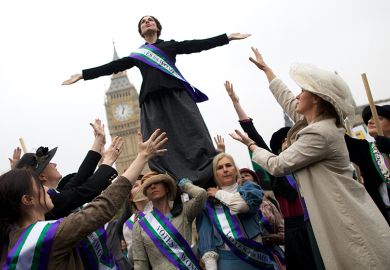Despite the decline in women's studies courses in higher education, books written from feminist perspectives continue to proliferate.
Chris Beasley's What is Feminism? is a user-friendly introduction to feminist theory in western societies, charting the development of liberal, radical and socialist feminisms, and exploring ethnicity, psychoanalysis, postmodernism, theories of the body and queer theory.
Valerie Bryson's Feminist Debates attempts to marry theory and practice by examining the situation of women in western societies in work and in the family; male violence against women; the development of reproductive technologies; the political representation of women; and the role of law in maintaining and challenging inequalities. Of particular interest is the chapter "The problem of men". Bryson's answer to the question, "What is a nice man to do?" is one every male academic should read. Until male academics identify their standpoint within the research process there is little hope of dropping those "invisible" prefixes within the disciplines about "neutrality".
The impact of feminism within academic disciplines has been uneven, and the final two books are aimed at students of social studies and cultural studies. Through Michel Foucault, poststructuralism and postmodernism, the body has become a fashionable area of focus, but much of this theorising is difficult for the uninitiated to access.
Barbara Brook's Feminist Perspectives on the Body does a brilliant job of making the complex simple, with useful summary points at the end of each chapter. We find discussions about pregnant, menstruating, menopausal, anorexic and cyberspace bodies, to name but a few. Wider questions about the absence of women as embodied subjects of the law are not ignored. Neither is the debate about the usefulness of post-structuralist theories.
Joanne Hollows's Feminism, Femininity and Popular Culture identifies key feminist approaches to popular culture from the 1960s to the 1990s, illustrating how the relationship between these three variables has often been problematic. For many second-wave feminists, "femininity" was the key to understanding women's subordinate position in western societies. Girls socialised into feminine values of submissiveness, it was claimed, were "colonised" by patriarchy. Hollows explores how feminist cultural studies has challenged the idea that the "feminine" is trivial and politically conservative.
Through a series of case studies - woman's film, romantic fiction, soap opera, and beauty practices - she guides us through the arguments developed in the field. As a feminist who in the 1980s attended women's groups in my high heels and make-up, I was intrigued by the chapter "Fashion and beauty practices", since many second-wave feminists regarded such adornment as a form of false consciousness. Hollows engages with the possibilities of beauty practices, exploring the ways in which they may be used as a form of resistance, as well as sites of pleasure.
These books, while not original in their analyses, offer competent and interesting overviews of the literature in their subject areas. Such level-headed texts are essential for the stimulus they offer for further reading.
June Purvis is professor of women's and gender history, University of Portsmouth.
Feminist Perspectives on the Body. First Edition
Author - Barbara Brook
ISBN - 0 582 35639 3
Publisher - Longman
Price - £16.99
Pages - 183
Register to continue
Why register?
- Registration is free and only takes a moment
- Once registered, you can read 3 articles a month
- Sign up for our newsletter
Subscribe
Or subscribe for unlimited access to:
- Unlimited access to news, views, insights & reviews
- Digital editions
- Digital access to THE’s university and college rankings analysis
Already registered or a current subscriber?



